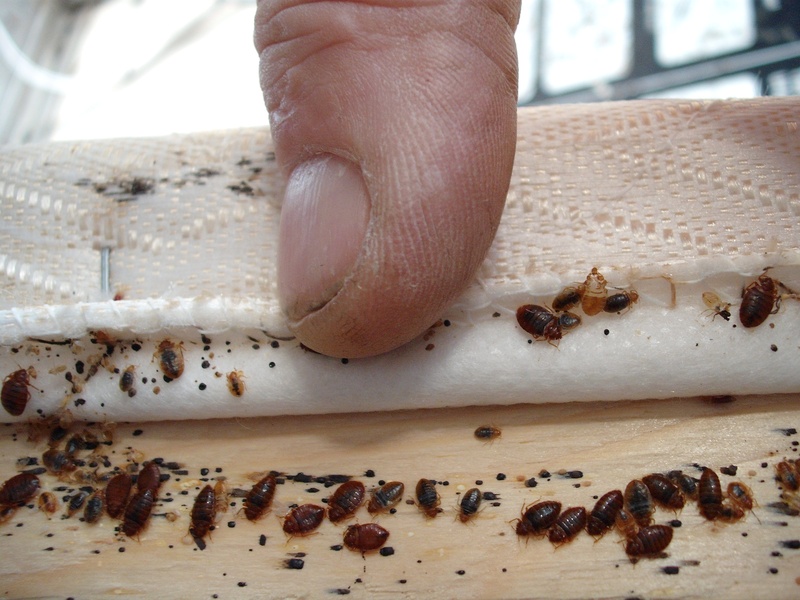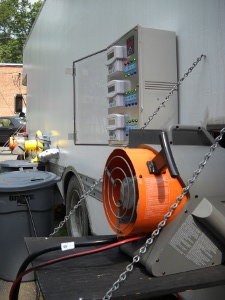100% Effective Bed Bug Treatment Found in MA
 Patrick Dente, co-owner of Abatem Exterminating in Massachusetts and Vermont, was sitting with his brother one evening going back and forth about ideas to confront the spreading infestation. “We realized there was a hole in the (treatment) market and we spent nearly a year coming up with the idea to create a heated truck,” said Patrick Dente. That was two years ago. In the mean time, brothers and co-owners Patrick and Daniel built their first heated truck in their back yard from a U-Haul. The Dente’s have now upgraded the technology in their trucks and are marketing the heat method nation-wide.
Patrick Dente, co-owner of Abatem Exterminating in Massachusetts and Vermont, was sitting with his brother one evening going back and forth about ideas to confront the spreading infestation. “We realized there was a hole in the (treatment) market and we spent nearly a year coming up with the idea to create a heated truck,” said Patrick Dente. That was two years ago. In the mean time, brothers and co-owners Patrick and Daniel built their first heated truck in their back yard from a U-Haul. The Dente’s have now upgraded the technology in their trucks and are marketing the heat method nation-wide.
“Heat is the only 100 percent way to kill bed bugs and their eggs,” said Dente. “Chemicals will never work 100 percent,” he added. Dente said that their heat method is extremely labor intensive, but in the end, you don’t need to throw your furniture away and far less pesticide is used in your home.
How bed bug heat treatment works:

The property owner packs up/boxes up their entire household of solid goods, furniture, electronics, or anything else that is moveable. Clothing, bedding, and other soft items such as plush toys are packed separately once washed and dried in hot water and high heat in a dryer for 30 minutes. The soft items are placed in different plastic bags once properly cleaned. Abatem has a trailer with portable clothes dryers to lessen infestation at local Laundromats. Companies in your area may opt to provide the same service.
The company you are using will move all of your furniture into a large (usually 24 feet long), specially equipped truck that will gradually heat up to 140 degrees over a couple of hour’s time. “Temperatures of 115 degrees will kill the bed bugs and their eggs, but we heat to 140 degrees for 100 percent eradication in a shorter period of time,” said Dente. “Bed bugs die at 115 degrees, but it takes a long time,” he said.
While your household items are being heat treated, the company then uses a residual EPA approved pesticide throughout your home. “Using the heat treatment really cuts down on the pesticide use by about ten times less,” said Dente. “It’s also a lot better than us having to go in and spray your underwear drawer for example,” he added.
The heat treatment takes about 2 ½ hours to bring up to temperature, then a couple of hours for a cool-down. “It’s a huge process, but that’s what you have to do to be thorough,” said Dente. Dente strongly emphasized that the treatment requires cooperation between his company, the tenant, and the landlord. “If anyone drops the ball, it’s not going to be successful,” he said. “We give them a list of everything they need to do.”
The technology of the heated trucks:
Patrick Dente, who is the inventor of the heated truck system, has 20 years experience in electronics. “My brother has 20 years experience in exterminating, so we made a good team,” he said. The newest version of their invention is now automated and computer controlled. “We’re also adding a wireless interface to connect to a lap top,” said Dente. The original model has to be manually operated by observing monitoring panels and making adjustments accordingly. Now, there are alarms and automatic shut-off systems should the system overload.
The insulated truck is heated by propane heaters. Sensors are placed around the truck which is fitted with a variety of racks and shelves. Sensors are also placed in between cushions and mattresses/box springs etc. Placing the sensors in many locations assures even heating (not just the air around the items) and proper monitoring. The newer version, depending on the outside temperature, is also faster.
The non-technical side of the business:
Due to perceived notions about who gets bed bugs, the trucks have no markings and good companies never even mention the word bed bug to anyone outside of the home being treated. Bed bugs can be found in every layer of society. Dente said infestations have nothing to do with how clean your home is or what socio-economic class you are in.
If you think you have bed bugs:
If you have checked suspected areas, such as bedding, upholstered furniture, electronics, and have either found what you think are bed bugs or red residue, call for a professional inspection. Sometimes people think they have bed bugs based on bites or welts they have. Dente said, “Different people react differently to bed bug bites, so bites are not always a clear indicator of infestation.”
How do bed bugs get into your home?
It is important to know that while uncomfortable or plain disgusting, bed bugs are not vectors for disease. Bed bugs do not fly or hop, but they can move very quickly. Bed bugs do not travel, they are hitchhikers. Most common ways bed bugs enter your home is via luggage, used furniture, bedding, or electronics. They are most often found in bedding and seams of beds and furniture. Bed bugs can also be found in carpeting, inside and underneath drawers or in radios, phones, and clocks near a bed. Bed bugs range from the size of a pin head to an apple seed and are flat. “They can live in cracks the size of a business card,” said Dente.
Dente said that the most important part of the process is education. “We ask a lot of questions and do a lot of education before we even start,” he said. Lastly, do not try using pesticides, bug bombs, or diatomaceous earth to try to get rid of bed bugs. Not only will it not work, you may endanger yourself, others or your pets.
Related Articles
Looking for a Pro? Call us (866) 441-6648

Pest control Average Costs
Exterminators Experiences

Mouse Control Got Rid Of A Small But Pesky Problem

Pest Control Got Rid Of Bedbugs From A "Bargain" Headboard



